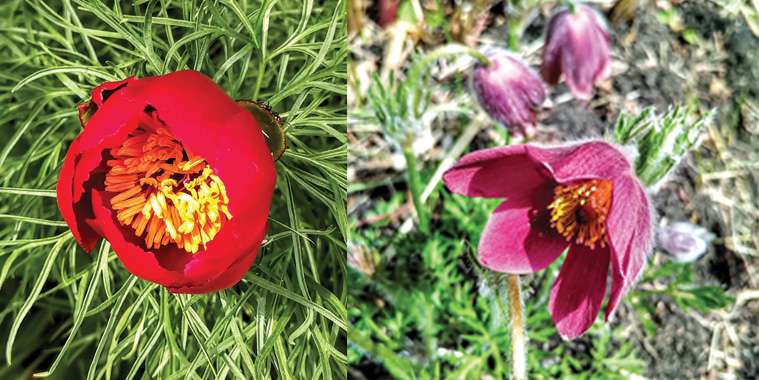Many people are looking at their gardens in disappointment this spring, spying perennial plants that look very dead at the crowns. Don’t panic yet; some may still emerge, although by now most plants, including the hosta, have popped up and may be a foot or taller depending on the variety.
Yet to show up in my garden, however, is the Asclepias (milkweed) although there may be a touch of green near the root. I am leaving it alone. The Joe Pye weed is another sleeper and I have my fingers crossed for this cheery beauty that adds so much to the fall garden. Not yet in evidence is the Russian sage and the 10-year-old smokebush is still waiting for some signal to leaf out. Even the prairie anemone has finally just bloomed – she is usually up early in the garden. In most springs, the Icelandic poppies would have flaunted their scarlet heads for a week already and disappeared, but they are still in bud. Even the fern peonies, usually so impatient once the snow leaves, have just opened their blossoms in a brightness of blood red.
A lot depends on location. A cool spot that gets only part sun or morning sun may be slower to produce flowers than one where the sun blazes down all day or in the afternoon. Dappled shade can also keep the ground fairly cool. The good thing, though, is that the daffodils will be with us longer, although the fickle tulips can’t seem to make it past a couple of weeks even in this weather.
Most worrisome are the cedars that suffered wind and sun burn and now look brown and dead. Check them carefully to see if there are any signs of green in the twigs, then hope for the best, but be prepared to accept that they may not have made it through. If the damage to the leaves is more than a third of the way you the branch, new leaves will not be produced form that branch. Fertilize your evergreens now with a 30-10-10 water soluble fertilizer in the root zone. Forget the hard fertilizer spikes you see at box stores. They are not efficient and take a long time to work. Chances are your once green beauties need an immediate boost.
Cytospera canker is also showing up in some Colorado spruce trees. It manifests as patches of purplish brown when the needles die and there may be brown to black streaks on the trunk. Prune the affected branches back to the trunk. Water and fertilize the tree and keep it free of spider mites by washing it two or three times this summer, including right now, with the sharpest spray the hose nozzle. That will dislodge other insects that may be residing there as well.
Every good garden has its share of shrubs including roses. The lovely copper-leafed Amber Jubilee Ninebark, bred by Jeffries, is a radiant celebration of spring right now. The leaves catch the sunlight and throw the glow all around. It’s a showstopper and, because it is ninebark, it is very reliable.
If you are wondering about the roses, don’t be surprised by a lot of dieback this year, but just wait – they will recover. If you planted Morden varieties or most of the Ottawa-bred shrub roses, the roots will still be viable and will send up new rose-bearing shoots. You can prune back any of the dead branches to green. The new Oso Easy roses are a bit tender and it will be interesting to see if they made it through this winter.
The thing with tenderer shrubs is to get them well established. Cover their crowns for the first two or three years until they have developed good roots. I have nurtured a tender variegated euonymous (zone 5) for the past six or seven years and, while it took a beating this winter, I see that there are signs on green.
Should you fertilize? Sure. Just use a water soluble product and follow the directions. If you added crown protection last fall, this should be removed by now and that includes any extra soil or heaps of peat moss you may have mounded around the plant. Scatter it and dig it into the soil.
While you are at it, the addition of any organic matter will be welcomed by all the living creatures down there that slave away processing the organics and, in so doing, release minerals in forms that plants can absorb.
Happy spring!
Dorothy Dobbie is the publisher of the Manitoba Gardener magazine; she also broadcasts a weekly
radio show on CJNU 93.7.



